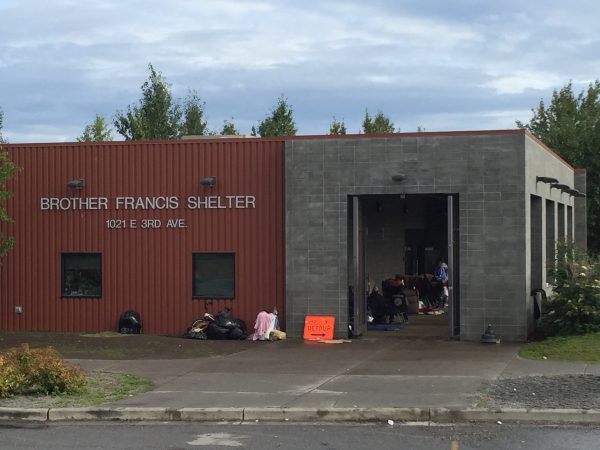
Officials in Anchorage say a new pilot program has radically cut down the emergency calls from the area surrounding the city’s main homeless shelter. News of the program’s apparent success took many elected leaders by surprise at an Assembly meeting on homelessness Wednesday at City Hall.
Since January 2nd, the city’s homeless coordinator, Nancy Burke, has been spearheading a new effort at the campus connecting Bean’s Cafe and the Brother Francis Shelter. They’ve had mental health professionals on the site, along with paramedics and police clearing people from the area if they aren’t utilizing shelter resources. The effect has been a dramatic drop in the number of calls for service to emergency responders, as representatives from different stakeholder groups told the Assembly.
“Calls for service were out of control,” said Lieutenant Jack Carson of the Anchorage Police Department. As problems with safety around the campus have increased, Carson said police responded around 2,800 times to the location a year. The figure is 7,500 responses when paramedics and personnel from the Fire Department are included.
“The calls are down a lot,” Carson said, referring to the last few weeks.
Assembly member Christopher Constant represents the downtown district encompassing the area, and says the program is an attempt to figure out how to make the environment safer for clients and staff alike.
“They have secured access after 6 p.m. You can’t just come on or drive on or walk on,” Constant explained. “They’re making people go inside when the shelter opens: you gotta go inside, you can’t just hang out.”
The city’s team, led by Burke, stress the effort is not intended to merely push people elsewhere, but is meant to connect people living on the streets with social services at the shelter while banning individual and behaviors that cause problems from the area. Officers from the Community Action Policing Team have been doing what Lieutenant Carson described as security work to clear a perimeter of people and campers from a multi-block radius.
The area will sometimes generate dozens of calls a day to police and paramedics for health emergencies, fights, and other problems. According to Carson, in the course of a recent weekend, APD received just seven. He and others foresee a dramatic reduction in the demand for overstretched emergency services if the programs are adopted long-term.
Constant has long been critical of how the city’s social services for the most needy residents are clustered in certain areas — most of which fall within the neighborhoods in his district. He regularly drives through the area at night, and says far fewer people are on the street around Bean’s and Brother Francis the last two weeks. Though he’s gotten calls from residents in adjacent neighborhoods complaining of new camping locations sprouting up, he doesn’t think it is near the number of people that would be lingering around the shelter on a given night. Constant and others say the new policies are getting more people into overflow shelter space.
Constant is further amazed that since the start of the year there have been days without a single 911 call to the area.
“It’s really quite stunning, the shift,” he said. “Any day you have zero calls for service at that location is a miracle.”
An escalating volume of paramedic and police visits to the campus has been a political controversy in Anchorage over the last several months. In November, the chair of the Assembly proposed a measure that would fine the social service providers for excessive calls for service — a move that didn’t advance very far, but angered many of those working with the city on the issue.
According to Burke, the homeless coordinator, the pilot program takes a different route towards addressing the same concerns brought up by the ordinance.
As officials assess data on what’s working, they are not yet sure when the specific provisions within the pilot will end.
Zachariah Hughes reports on city & state politics, arts & culture, drugs, and military affairs in Anchorage and South Central Alaska.
@ZachHughesAK About Zachariah




